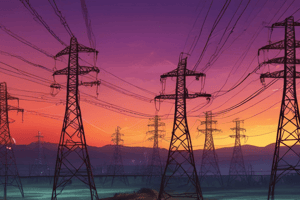Podcast
Questions and Answers
What is the primary role of high-voltage transmission lines in power systems?
What is the primary role of high-voltage transmission lines in power systems?
- Generating electricity from renewable sources
- Transforming electrical energy into mechanical energy
- Distributing electricity to consumers
- Transporting electricity over long distances (correct)
Which type of load describes the energy consumption patterns in commercial buildings?
Which type of load describes the energy consumption patterns in commercial buildings?
- Industrial load
- Peak load
- Commercial load (correct)
- Residential load
What is the main advantage of AC transmission over DC transmission?
What is the main advantage of AC transmission over DC transmission?
- Ease of voltage transformation (correct)
- Ability to transmit power over shorter distances
- Lower line losses
- More efficient at higher voltages
What is the purpose of protective relays in power systems?
What is the purpose of protective relays in power systems?
In power system analysis, what does short circuit analysis focus on?
In power system analysis, what does short circuit analysis focus on?
What is a smart grid?
What is a smart grid?
Which of the following components is involved in converting electrical energy into mechanical energy?
Which of the following components is involved in converting electrical energy into mechanical energy?
What aspect of power systems does reliability refer to?
What aspect of power systems does reliability refer to?
Flashcards are hidden until you start studying
Study Notes
Overview of Power Systems in Electrical Engineering
- Power systems involve generation, transmission, distribution, and utilization of electrical energy.
- They are critical for delivering electricity to consumers and industries.
Components of Power Systems
-
Generation:
- Sources: Fossil fuels, nuclear, hydro, wind, solar, and geothermal.
- Types of generation: Centralized (large power plants) and decentralized (distributed generation).
-
Transmission:
- High-voltage transmission lines transport electricity over long distances.
- Transformers step up voltage for transmission and step down for distribution.
- AC vs. DC transmission: AC is more common due to ease of voltage transformation.
-
Distribution:
- Distributes electricity from substations to end users.
- Includes distribution lines, transformers, and switchgear.
- Distribution systems can be radial, ring, or mesh.
-
Utilization:
- Involves end-user applications, such as residential, commercial, and industrial loads.
- Electric machines (motors, generators) convert electrical energy into mechanical energy.
Key Concepts
-
Load:
- Refers to the power consumption by devices and systems.
- Types: Residential, commercial, industrial, and peak loads.
-
Grid:
- A network for delivering electricity from producers to consumers.
- Smart grids incorporate digital technology for real-time monitoring and management.
-
Reliability and Stability:
- Reliability: The ability of a power system to provide uninterrupted service.
- Stability: The ability to maintain equilibrium under normal and disturbed conditions.
Power System Analysis
-
Power Flow Analysis:
- Determines the flow of electrical power in the system.
- Tools: Load flow studies using methods like Newton-Raphson and Gauss-Seidel.
-
Short Circuit Analysis:
- Analyzes system behavior during faults or short circuits.
- Important for protective device coordination.
-
Transient Stability Analysis:
- Examines system response to disturbances over a short period.
- Assesses how quickly the system can return to steady state.
Control and Protection
-
Control Systems:
- Automatic control of generation and load balancing.
- Uses systems like Automatic Generation Control (AGC) and Voltage Regulation.
-
Protection Systems:
- Employs protective relays and circuit breakers to isolate faults.
- Ensures safety and minimizes equipment damage.
Current Trends and Challenges
- Integration of renewable energy sources into existing grids.
- Enhancements in energy storage technologies (e.g., batteries).
- Cybersecurity concerns with smart grid technologies.
- Regulatory and environmental considerations impacting power generation methods.
Overview of Power Systems
- Power systems encompass the essential processes of generating, transmitting, distributing, and utilizing electrical energy.
- They play a vital role in providing electricity to various sectors, including residential and industrial consumers.
Components of Power Systems
-
Generation:
- Major energy sources include fossil fuels, nuclear, hydro, wind, solar, and geothermal.
- Types of generation can be categorized as centralized (large-scale power plants) or decentralized (smaller, distributed generation).
-
Transmission:
- High-voltage lines are utilized for the long-distance transportation of electricity.
- Transformers are crucial for increasing voltage levels during transmission and reducing them for distribution.
- AC (Alternating Current) is predominantly used over DC (Direct Current) due to the simplicity of voltage transformation.
-
Distribution:
- The distribution segment delivers electricity from substations to final users via distribution lines and transformers.
- Common configurations include radial, ring, and mesh distribution systems.
-
Utilization:
- This stage focuses on how electrical energy is used in residential, commercial, and industrial applications.
- Electric machines such as motors and generators convert electrical energy into mechanical energy for various tasks.
Key Concepts
-
Load:
- Represents the consumption of power by various devices and systems.
- Types of loads include residential, commercial, industrial, and peak loads experienced during high usage times.
-
Grid:
- Refers to the network that facilitates the transfer of electricity from producers to end consumers.
- Smart grids enhance traditional grids with digital technology, enabling real-time monitoring and management of electricity flow.
-
Reliability and Stability:
- Reliability pertains to a power system's capability to deliver continuous service without interruptions.
- Stability refers to maintaining equilibrium within the system during normal operations and in the event of disturbances.
Power System Analysis
-
Power Flow Analysis:
- Investigates the flow of electrical power throughout the system.
- Techniques such as Newton-Raphson and Gauss-Seidel methods are key tools for conducting load flow studies.
-
Short Circuit Analysis:
- Evaluates the system's behavior during electrical faults or short circuits, emphasizing protective device coordination.
-
Transient Stability Analysis:
- Assesses how the power system responds to disturbances over brief periods and measures recovery time to achieve steady state.
Control and Protection
-
Control Systems:
- Systems like Automatic Generation Control (AGC) are used for the automatic balancing of generation and load.
- Voltage regulation plays a important role in maintaining stable operations within the power system.
-
Protection Systems:
- Protective relays and circuit breakers serve to isolate faults, ensuring safety and preventing damages to equipment.
Current Trends and Challenges
- The integration of renewable energy sources is increasingly incorporated into existing power grids.
- Advancements in energy storage technologies, such as batteries, are facilitating more efficient energy management.
- Cybersecurity poses significant challenges related to smart grid technologies.
- Regulatory and environmental issues are influencing the methods used for power generation.
Studying That Suits You
Use AI to generate personalized quizzes and flashcards to suit your learning preferences.




